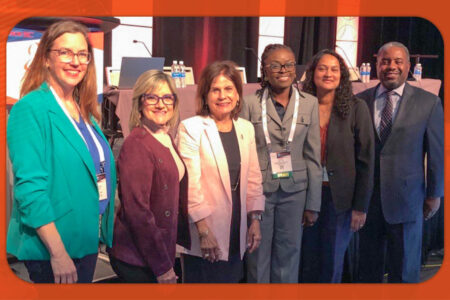Share On Social!
About 19 million Americans lack access to broadband services, according to the Federal Communications Commission (FCC).
Of those 19 million, the majority are in low-income and rural communities and communities of color.
This “digital divide” is problematic, especially as students and families have needed to rely on the internet for online learning and telehealth during the COVID-19 pandemic.
Thankfully, businesses and the federal government are stepping up to help these areas by expanding broadband access.
In his $2.3 trillion infrastructure plan, President Joe Biden proposed expanding broadband services to low income, rural areas.
Comcast also recently announced their decision to invest in low-income areas to close the digital divide.
Together, initiatives like these can help Latinos and other people of color get equitable access to online opportunities.
Update 5/12/21: The Federal Communications Commission (FCC) opened enrollment for the Emergency Broadband Benefit Program, which provides discounted internet services and digital equipment to low-income households.
What are the Initiatives to Expand Broadband Access?
The Biden administration wants to dedicate part of his infrastructure package to expanding broadband networks.
“It would spend $100 billion to ‘future-proof’ broadband as part of an eight-year infrastructure plan, calling high-speed connections ‘the new electricity’ that’s now a necessity for all Americans,” said Tali Arbel, according to USA Today.
If supported in Congress, Biden’s plan would make the cost of broadband more affordable.
“It pushes for greater competition that could lower prices, by encouraging and supporting networks owned or affiliated with local governments, cooperatives and nonprofit organizations. Currently, roughly 20 states restrict municipal broadband. Prioritizing such networks could give them a leg up when the government doles out money for extending service,” Arbel said, according to USA Today.
Additionally, Biden’s plan will provide subsidies to address high costs of internet.
Former politicians working in the telecommunications industry have signaled support for Biden’s plan.
“The most important thing about what President Biden has done in the proposal is that he’s redefined the digital divide,” said Larry Irving, a top telecom official in the Clinton administration, according to USA Today. “The simple act of recognizing that poverty is a bigger indicator of lack of access than geography is a huge statement.”
Other political figures have criticized the plan for potentially hurting private investment in networks, and think the cost is too high.
In the private sector, plans to address the digital divide are spread out over time.
Comcast recently announced that over the next 10 years, the company plans to invest $1 billion in closing the digital divide.
“The $1 billion commitment will include additional support of its Lift Zone initiative. The initiative will establish Wi-Fi-connected safe spaces in more than 1,000 community centers across the nation by the end of this year. The initiative will also donate computers, give grants to nonprofit community organizations to create opportunities in media, technology, and entrepreneurship. Additionally, the cable and internet giant will continue its investment in the Internet Essentials program,” according to Black Enterprise.
Comcast’s investment has gained the support of Latino-focused organizations.
“For a decade Comcast’s Internet Essentials program has provided Latino families with tools and resources to access high-speed Internet at home. Hispanic Federation has been proud to partner with Comcast and work with this program to bridge the digital divide and offer Latino communities the opportunity to access health, educational, and economic resources online,” said Brent Wilkes, senior vice president at the Hispanic Federation, according to Black Enterprise. “We look forward to the next ten years of partnership with Comcast as we tackle more challenges in our ever-changing digital world.”
How Does the Digital Divide Affect Latinos?
Lack of internet access can lead to disconnected families.
This has been especially worrisome during the COVID-19 pandemic, as schools have shifted to online or hybrid virtual and in-person learning.
According to research from Latino Decisions and Abriendo Puertas/Opening Doors, Latino parents have several concerns about how internet access affects their children’s education.
According to the survey from Abriendo Puertas/Opening Doors:
- 33% of Latino families do not have regular access to the internet, 37% only have access from cell phones
- 58% of Latino parents feel online schoolwork has been difficult because of technical problems, such as websites or programs not working
- 51% of Latino parents find their internet and/or cell phone bill is much higher now because increased usage is needed for online school.
- 50% of Latino parents do not have enough computers, laptops, or tablets for everyone in the household.
Latinos in rural areas of Texas have felt the digital divide especially.

“Rural communities often don’t have near the funds or the resources as your more urban communities,” says Debbie Bresett, the executive director of Bastrop County Cares, a nonprofit organization dedicated to improving the lives of the county’s citizens. “I think the school districts are working as best they can to provide.”
In addition to education, lack of internet access has impacted the ability for rural communities to receive telehealth care.
“Access to high-speed broadband internet continues to be a barrier for many rural telehealth programs. Lack of connectivity can hinder the implementation and expansion of telehealth programs that require live-video connections between patients and providers. Dropped calls and delays in video feeds can interrupt care delivery and lead to patient dissatisfaction with telehealth,” according to the Rural Health Information Hub.
Lack of access to telehealth resources have especially impacted Latinos and other people of color, who have also been disproportionately hurt by COVID-19.
“Patients face three overlapping barriers to accessing telehealth: the absence of technology, digital literacy, and reliable internet coverage. Together, these barriers comprise the digital divide, which disproportionately affects older people of color and those with low socioeconomic status. These obstacles are even more insurmountable at a time when doctors are closing their outpatient clinics and delivering care exclusively from their homes, using computers or smartphones to contact their patients through video or phone calls,” according to Health Affairs.
How Can We Help Latinos and Address the Digital Divide?
Lack of internet access can lead to many problems for Latinos and other communities of color, in addition to low income, rural communities, such as learning loss during the pandemic and lack of access to online health care and resources.
Schools can step up. They can help prevent learning loss by giving more technical support, one-on-one tutoring options, more in-person or virtual time with teachers, more direction on creating at-home learning schedules, according to the survey from Abriendo Puertas/Opening Doors.
To help address the lack of access to telehealth care, Rural Health Information Hub recommends that healthcare providers build partnerships with rural communities, adapt services to use text messaging rather than online video calls, and take advantage of resources from the FCC, like the Universal Service Fund and Connect America Fund.
If Biden’s broadband infrastructure plan is passed in Congress, it will also give substantial support to rural, Latino communities.
Until more policy helping Latinos is passed, we can do our part to advocate for Latinos and for health equity for all people.
You can help by downloading the Health Equity Report Card from Salud America!
The report card allows you to see what access your community has to healthcare, food, education, and other resources. You can help advocate for your neighbors and present the Health Equity Report Card to your city’s leadership!
By The Numbers
142
Percent
Expected rise in Latino cancer cases in coming years



